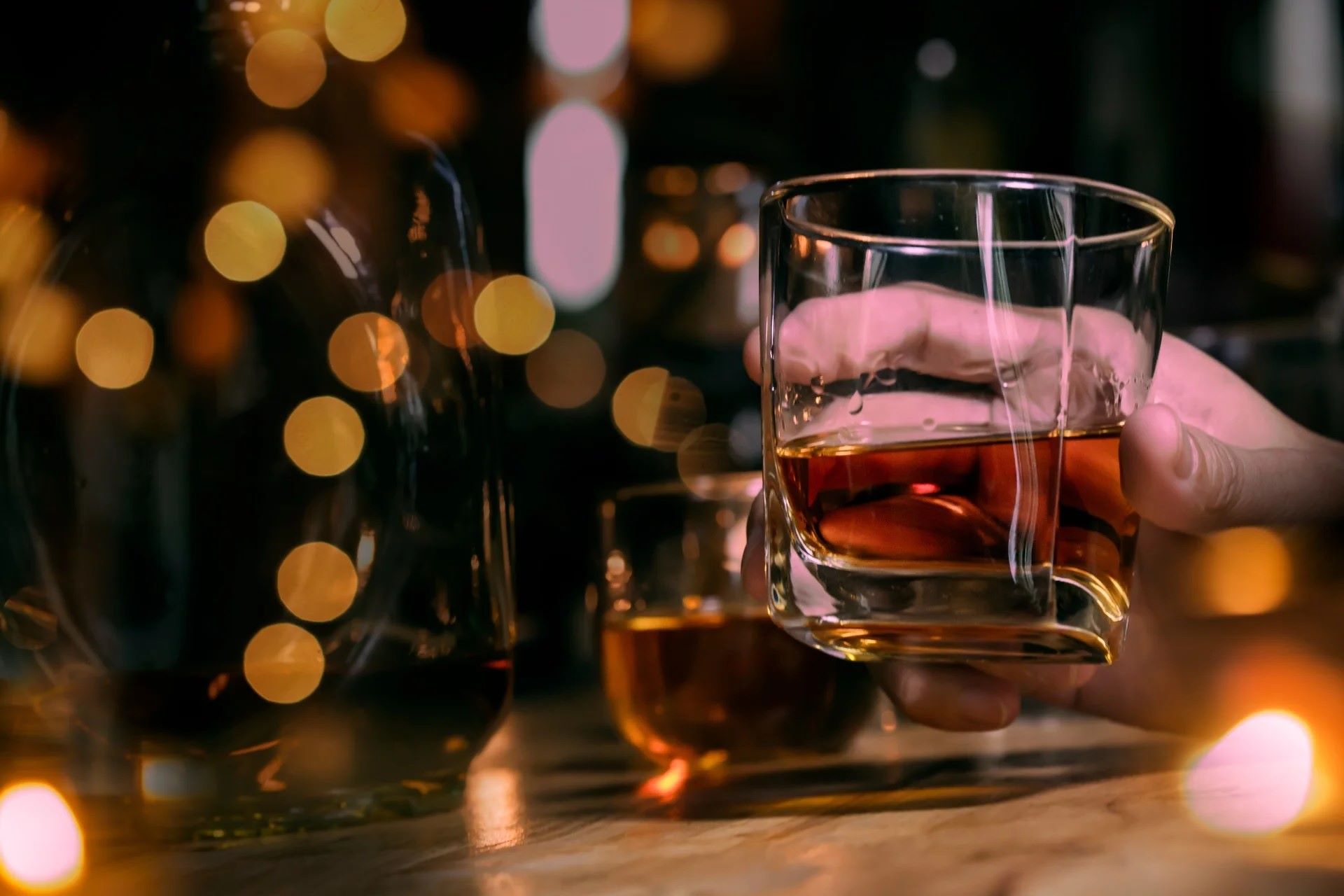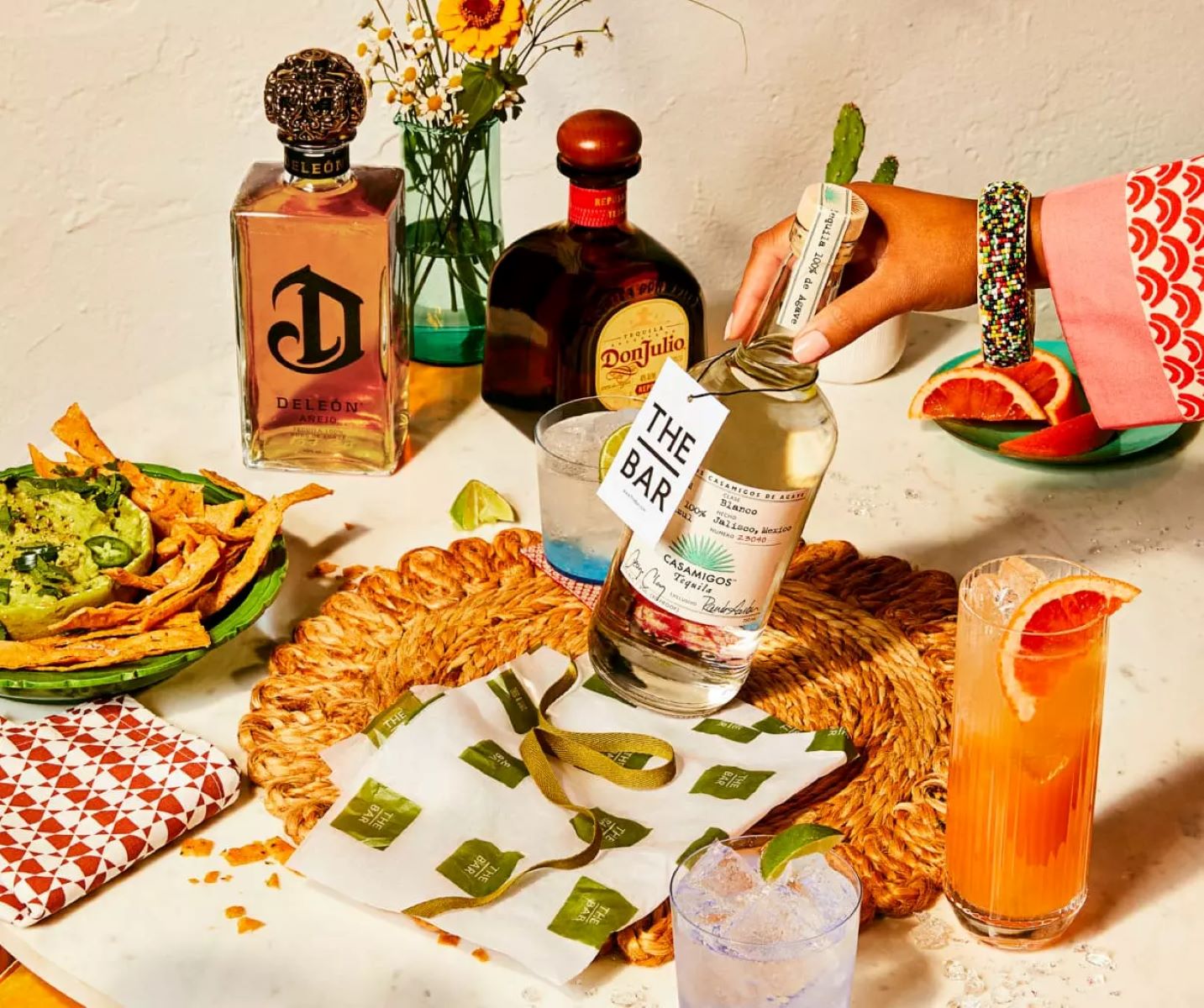Home>Food and Cooking>How To Drink Bourbon


Food and Cooking
How To Drink Bourbon
Published: February 29, 2024
Learn the art of savoring bourbon with our expert tips and techniques. Discover the perfect food pairings and cooking recipes to elevate your bourbon experience. Unlock the secrets of bourbon enjoyment today!
(Many of the links in this article redirect to a specific reviewed product. Your purchase of these products through affiliate links helps to generate commission for Regretless.com, at no extra cost. Learn more)
Table of Contents
Introduction
Bourbon, often hailed as "America's native spirit," has a rich history and a devoted following. This iconic whiskey, with its deep amber hue and complex flavors, has captured the hearts of enthusiasts around the world. Whether enjoyed neat, on the rocks, or as a key ingredient in classic cocktails, bourbon offers a sensory journey that transcends mere consumption.
As we delve into the world of bourbon, we'll explore its origins, the art of serving and tasting, and even discover how to pair it with delectable dishes. Whether you're a seasoned bourbon aficionado or a curious newcomer, this guide will equip you with the knowledge and skills to savor this timeless libation to the fullest.
So, grab your favorite bottle, a glass, and let's embark on a captivating exploration of bourbon – from its storied past to the nuanced art of sipping and savoring.
Understanding Bourbon
Bourbon, a quintessential American whiskey, is steeped in tradition and craftsmanship. To be classified as bourbon, the spirit must meet specific criteria. It is primarily made from a grain mixture that is at least 51% corn, giving it a distinct sweetness. The production process involves aging the spirit in charred oak barrels, which imparts rich, caramelized flavors and a deep amber hue.
One of the defining characteristics of bourbon is its aging process. By law, bourbon must be aged in new, charred oak barrels. This requirement contributes to the whiskey's unique profile, infusing it with notes of vanilla, caramel, and oak. The aging process also allows the spirit to mellow and develop complex flavors over time.
Furthermore, the geographical significance of bourbon cannot be overstated. While it can be produced anywhere in the United States, it is most closely associated with the state of Kentucky. The limestone-rich water in this region, along with its distinct climate, plays a crucial role in shaping the flavor profile of bourbon.
Bourbon's flavor profile is a harmonious blend of sweet, spicy, and oaky notes, making it a versatile spirit that can be enjoyed in various ways. Whether sipped neat to appreciate its nuanced flavors, mixed into classic cocktails like the Old Fashioned or Manhattan, or savored alongside a flavorful meal, bourbon offers a diverse range of sensory experiences.
In essence, understanding bourbon goes beyond its ingredients and production process. It encompasses an appreciation for the artistry and heritage that define this beloved spirit. As we continue our exploration, we will delve into the art of serving and tasting bourbon, unlocking the secrets to fully savoring its depth and complexity.
Choosing the Right Glassware
Selecting the appropriate glassware for enjoying bourbon is essential for enhancing the overall tasting experience. The right vessel can accentuate the whiskey's aromas and flavors, allowing you to fully appreciate its complexity. When it comes to bourbon, there are several types of glassware that are well-suited for savoring this iconic spirit.
Glencairn Glass
The Glencairn glass is a popular choice among bourbon enthusiasts. Its tulip-shaped design concentrates the aromas, directing them toward the nose and enhancing the olfactory experience. The wide bowl allows for easy swirling, releasing the whiskey's bouquet and revealing its intricate layers of scent. The narrow opening captures the aromas, ensuring that every sip is a sensory delight.
Old Fashioned Glass
Also known as a rocks glass, the Old Fashioned glass is a classic option for enjoying bourbon. Its sturdy, low-profile design makes it ideal for serving bourbon on the rocks or in cocktails like the Old Fashioned. The wide opening provides ample space for ice cubes, allowing the whiskey to mellow and unfold gradually as it is savored.
Copita Glass
The Copita glass, with its narrow bowl and elongated stem, is often used for tasting and nosing spirits. While traditionally associated with sherry, it has gained popularity among bourbon connoisseurs for its ability to concentrate aromas and deliver a refined tasting experience. The elongated shape allows for precise nosing, capturing the whiskey's nuances with each gentle swirl.
Snifter Glass
The snifter, renowned for its use with brandy and cognac, is also well-suited for savoring bourbon. Its wide bowl and short stem encourage swirling, aerating the whiskey and intensifying its aromas. The shape of the snifter allows the whiskey to be cradled in the hand, gently warming it and enhancing the release of its aromatic compounds.
When selecting the right glassware for bourbon, it's important to consider the occasion and the manner in which the whiskey will be enjoyed. Whether you prefer the concentrated aromas of a Glencairn glass, the classic appeal of an Old Fashioned glass, the refined elegance of a Copita glass, or the sensory experience of a snifter, choosing the appropriate vessel is a crucial step in elevating your bourbon enjoyment.
Serving Bourbon
Serving bourbon is an art that involves attention to detail and a deep appreciation for the whiskey's nuanced characteristics. Whether you're hosting a gathering or simply indulging in a solitary moment of relaxation, the manner in which bourbon is served can significantly impact the overall experience. From the selection of the whiskey to the presentation and serving temperature, every aspect contributes to the enjoyment of this revered spirit.
Selecting the Bourbon
The first step in serving bourbon is choosing the right bottle. With a myriad of options available, each with its own flavor profile and aging characteristics, selecting a bourbon that aligns with your preferences is crucial. Whether you opt for a well-aged, small-batch bourbon with complex layers of flavor or a younger, more vibrant expression, the choice should reflect your desired tasting experience.
Presentation
Once the bourbon is selected, the presentation plays a pivotal role in setting the stage for an enjoyable tasting. Pouring the whiskey into a clean, well-chosen glassware, such as a Glencairn glass or an Old Fashioned glass, adds an element of refinement to the ritual. The visual appeal of the amber liquid, coupled with the anticipation of its aromas and flavors, enhances the overall sensory experience.
Serving Temperature
The serving temperature of bourbon is a critical factor that can significantly influence its taste and aroma. While some prefer to enjoy bourbon at room temperature to fully appreciate its complexity, others find that a slight chill can mellow the spirit and accentuate certain flavors. Ultimately, the ideal serving temperature is a matter of personal preference. However, it's essential to avoid serving bourbon at excessively low temperatures, as this can dull its flavors and diminish its aromatic qualities.
Dilution and Garnishes
For those who prefer their bourbon with a touch of dilution, adding a few drops of water can open up the whiskey, releasing additional layers of flavor and aroma. Additionally, garnishes such as a twist of citrus peel or a Luxardo cherry can complement the bourbon's profile, adding subtle nuances to the tasting experience. However, purists may choose to savor the whiskey in its unadulterated form, allowing its inherent characteristics to shine through without any additional elements.
The Ritual of Serving
Finally, the ritual of serving bourbon encompasses more than just the physical act of pouring and presenting the whiskey. It involves creating an ambiance that encourages mindfulness and appreciation for the spirit. Whether it's a moment of quiet contemplation or a convivial gathering among friends, the act of serving bourbon is an invitation to savor the present moment and immerse oneself in the sensory pleasures that this timeless libation offers.
In essence, serving bourbon is a multi-faceted endeavor that involves thoughtful consideration of the whiskey itself, the presentation, serving temperature, and the overall experience. By paying attention to these details, one can elevate the act of serving bourbon from a simple pour to a captivating ritual that celebrates the artistry and heritage of this beloved spirit.
Tasting Bourbon
Tasting bourbon is an immersive experience that invites enthusiasts to explore the whiskey's intricate flavors, aromas, and textures. Whether sipped neat, with a splash of water, or as part of a curated tasting flight, the art of tasting bourbon involves a deliberate and mindful approach to fully appreciate its nuances.
The Visual Assessment
The tasting journey begins with a visual assessment of the bourbon. Pouring the whiskey into a suitable glassware, such as a Glencairn glass, allows for a closer inspection of its appearance. Observing the whiskey's color and clarity provides initial insights into its age, cask influence, and potential flavor profile. Bourbon's rich amber hue, often reminiscent of polished mahogany or golden honey, hints at the aging process and the depth of flavors waiting to be discovered.
The Aromatic Exploration
Engaging the sense of smell is a crucial aspect of tasting bourbon. Gently swirling the whiskey in the glass releases a symphony of aromas, inviting the taster to delve into its complex bouquet. Notes of caramel, vanilla, oak, and spice intertwine, offering a sensory journey that evokes images of oak-lined distilleries and sun-drenched cornfields. Each inhalation reveals new layers of scent, unveiling the whiskey's character and inviting anticipation for the forthcoming tasting experience.
The Palate Journey
Savoring the first sip of bourbon is a moment of revelation. The whiskey's texture, body, and mouthfeel come to the forefront, captivating the palate with a harmonious interplay of flavors. The initial sweetness of corn, the warmth of oak, and the subtle interplay of spices create a tapestry of taste that unfolds with each sip. Swirling the whiskey in the mouth allows for a thorough exploration of its complexities, from the initial burst of flavor to the lingering, satisfying finish that leaves a lasting impression.
The Finish
The finish of bourbon, often referred to as the "length," is a defining aspect of the tasting experience. As the whiskey is savored, the flavors gradually evolve, revealing new dimensions and nuances. The finish can be characterized by its length, intensity, and the lingering impressions it leaves on the palate. Whether it's a smooth, lingering warmth or a crescendo of spice and oak, the finish encapsulates the essence of the bourbon, leaving a lasting imprint that beckons another sip.
The Art of Tasting
In essence, tasting bourbon is an art that demands attention to detail, patience, and a willingness to immerse oneself in the whiskey's sensory tapestry. Each sip offers a new revelation, inviting the taster to explore the whiskey's depth and complexity. Whether enjoyed in solitude or shared among fellow enthusiasts, the act of tasting bourbon is a celebration of craftsmanship, heritage, and the timeless allure of this revered spirit.
Pairing Bourbon with Food
Pairing bourbon with food is an art that involves harmonizing the whiskey's robust flavors with complementary dishes, creating a sensory symphony that elevates the dining experience. The complex profile of bourbon, characterized by its sweet, spicy, and oaky notes, offers a versatile canvas for pairing with a wide range of culinary delights.
Flavor Affinities
When considering food pairings for bourbon, it's essential to understand the flavor affinities that enhance the tasting experience. The whiskey's caramel and vanilla undertones harmonize beautifully with dishes featuring rich, savory flavors. Additionally, the spice and oak notes in bourbon can complement the smoky, charred elements found in grilled or barbecued fare.
Classic Pairings
Classic pairings for bourbon often include dishes that showcase bold, robust flavors. For example, the sweet and smoky notes of bourbon can accentuate the richness of barbecued ribs or pulled pork, creating a harmonious balance of flavors. Furthermore, the whiskey's caramel undertones can complement the sweetness of glazed meats, adding depth to the overall dining experience.
Exploration of Contrasts
While classic pairings offer delightful harmony, exploring contrasting flavor profiles can also yield captivating results. The spicy kick of bourbon can provide a compelling counterpoint to creamy or tangy dishes, such as spicy buffalo wings or tangy barbecue sauces. The interplay of contrasting flavors creates a dynamic dining experience that tantalizes the palate.
Dessert Pairings
Bourbon's sweet and oaky characteristics make it an ideal companion for desserts. The whiskey's caramel and vanilla notes can enhance the indulgent flavors of desserts like bread pudding, pecan pie, or dark chocolate truffles. The interplay of sweet and savory elements creates a memorable finale to a dining experience, leaving a lasting impression on the palate.
Culinary Creativity
Pairing bourbon with food offers endless opportunities for culinary creativity. From experimenting with bourbon-infused sauces and marinades to crafting innovative dessert pairings, the art of combining bourbon with food invites culinary enthusiasts to explore new dimensions of flavor and texture.
In essence, pairing bourbon with food is a delightful exploration of flavor affinities and contrasts, offering a myriad of possibilities to elevate the dining experience. Whether savoring classic pairings that celebrate the whiskey's rich, savory notes or venturing into the realm of culinary creativity, the art of pairing bourbon with food invites enthusiasts to embark on a sensory journey that celebrates the harmony of flavors.
Conclusion
In conclusion, the world of bourbon is a captivating realm that intertwines tradition, craftsmanship, and sensory delight. From its origins as America's native spirit to its enduring legacy as a beloved whiskey, bourbon embodies a rich tapestry of history, artistry, and flavor. As we've journeyed through the nuances of understanding, serving, tasting, and pairing bourbon, it becomes evident that this iconic spirit transcends mere libation – it is a cultural emblem that invites enthusiasts to savor the present moment and celebrate the art of indulgence.
Understanding bourbon goes beyond its ingredients and production process; it encompasses an appreciation for the artistry and heritage that define this beloved spirit. The meticulous aging process, the influence of charred oak barrels, and the geographical significance of bourbon production all contribute to its distinctive character. This understanding sets the stage for a deeper connection with the whiskey and an enhanced appreciation of its complexities.
Choosing the right glassware for enjoying bourbon is essential for enhancing the overall tasting experience. Whether opting for the concentrated aromas of a Glencairn glass, the classic appeal of an Old Fashioned glass, the refined elegance of a Copita glass, or the sensory experience of a snifter, selecting the appropriate vessel is a crucial step in elevating the enjoyment of bourbon.
Serving bourbon is an art that involves attention to detail and a deep appreciation for the whiskey's nuanced characteristics. From the selection of the bourbon to the presentation, serving temperature, and the ritual of serving, every aspect contributes to the enjoyment of this revered spirit.
Tasting bourbon is an immersive experience that invites enthusiasts to explore the whiskey's intricate flavors, aromas, and textures. Engaging the senses through visual assessment, aromatic exploration, palate journey, and the appreciation of the finish, the art of tasting bourbon demands attention to detail, patience, and a willingness to immerse oneself in the whiskey's sensory tapestry.
Pairing bourbon with food is an art that involves harmonizing the whiskey's robust flavors with complementary dishes, creating a sensory symphony that elevates the dining experience. Whether savoring classic pairings or exploring culinary creativity, the art of combining bourbon with food invites enthusiasts to embark on a sensory journey that celebrates the harmony of flavors.
In essence, the world of bourbon offers a multifaceted exploration of flavor, tradition, and indulgence. Whether enjoyed in solitude, shared among friends, or paired with delectable dishes, bourbon invites enthusiasts to savor the present moment, celebrate craftsmanship, and immerse themselves in the timeless allure of this revered spirit.









